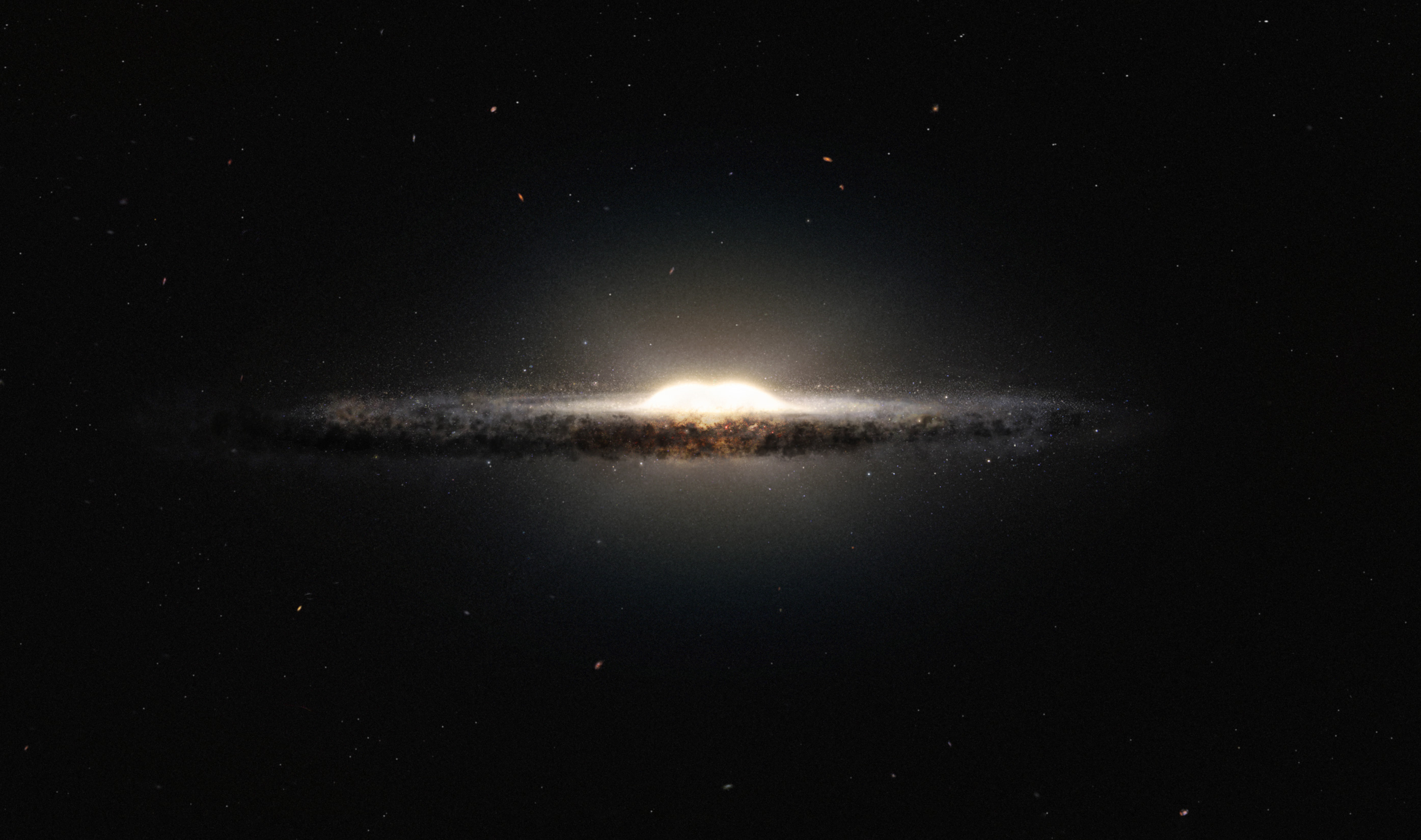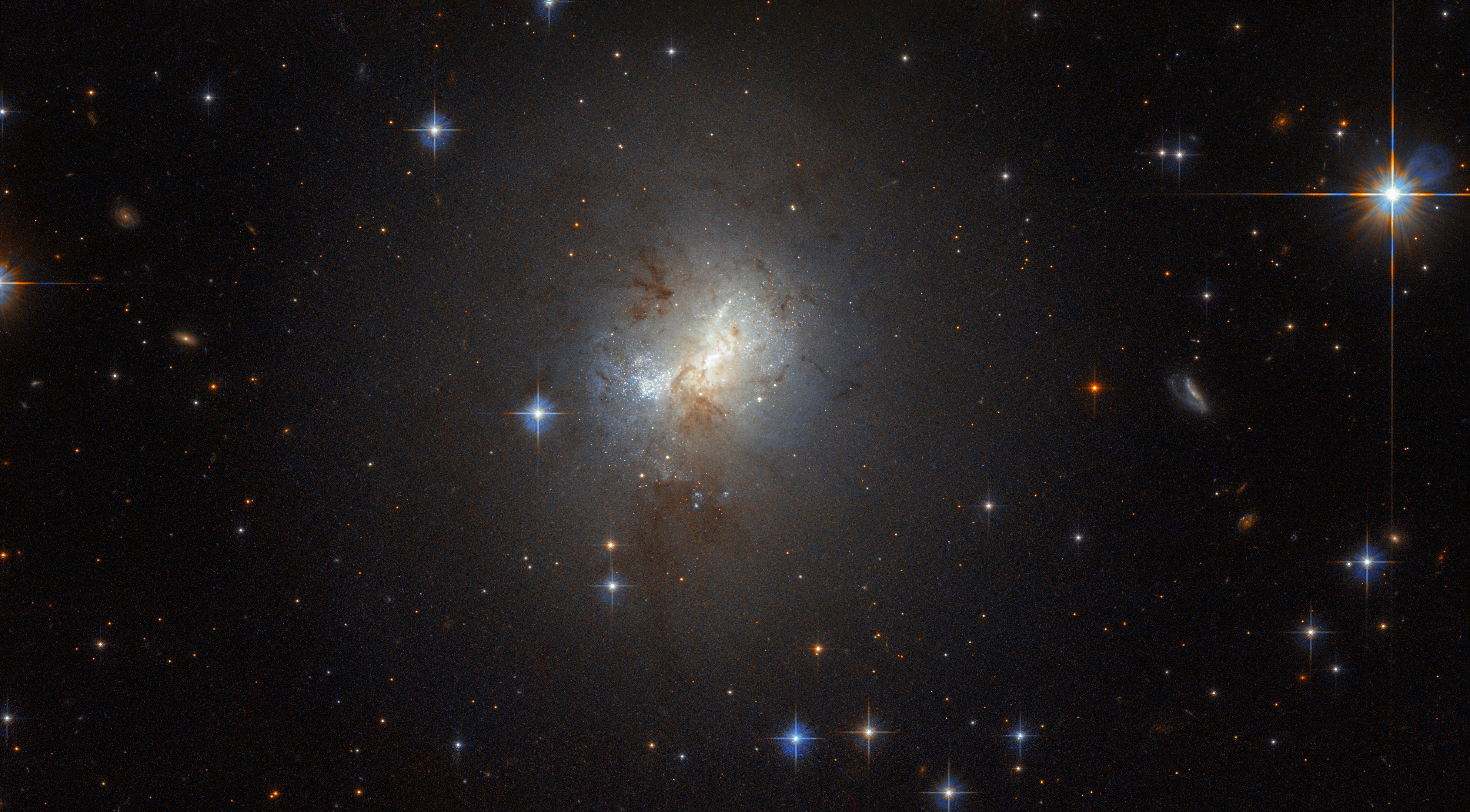Bulge (astronomy) on:
[Wikipedia]
[Google]
[Amazon]
 In
In
 Many bulges have properties more similar to those of the central regions of spiral galaxies than elliptical galaxies.
They are often referred to as ''pseudobulges'' or ''disky-bulges.'' These bulges have stars that are not orbiting randomly, but rather orbit in an ordered fashion in the same plane as the stars in the outer disk. This contrasts greatly with elliptical galaxies.
Subsequent studies (using the
Many bulges have properties more similar to those of the central regions of spiral galaxies than elliptical galaxies.
They are often referred to as ''pseudobulges'' or ''disky-bulges.'' These bulges have stars that are not orbiting randomly, but rather orbit in an ordered fashion in the same plane as the stars in the outer disk. This contrasts greatly with elliptical galaxies.
Subsequent studies (using the
/ref> This structure often looks similar to a
 Most bulges and pseudo-bulges are thought to host a central relativistic compact mass,
which is traditionally assumed to be a
Most bulges and pseudo-bulges are thought to host a central relativistic compact mass,
which is traditionally assumed to be a SPACE.com - Even Thin Galaxies Pack Hefty Black Holes
The implication is that the bulge environment is not strictly essential to the initial seeding and growth of massive black holes.
 In
In astronomy
Astronomy () is a natural science that studies astronomical object, celestial objects and phenomena. It uses mathematics, physics, and chemistry in order to explain their origin and chronology of the Universe, evolution. Objects of interest ...
, a galactic bulge (or simply bulge) is a tightly packed group of star
A star is an astronomical object comprising a luminous spheroid of plasma (physics), plasma held together by its gravity. The List of nearest stars and brown dwarfs, nearest star to Earth is the Sun. Many other stars are visible to the naked ...
s within a larger star formation. The term almost exclusively refers to the central group of stars found in most spiral galaxies
Spiral galaxies form a class of galaxy originally described by Edwin Hubble in his 1936 work ''The Realm of the Nebulae''galactic spheroid
Spiral galaxies form a class of galaxy originally described by Edwin Hubble in his 1936 work ''The Realm of the Nebulae''elliptical galaxies
An elliptical galaxy is a type of galaxy with an approximately ellipsoidal shape and a smooth, nearly featureless image. They are one of the four main classes of galaxy described by Edwin Hubble in his Hubble sequence and 1936 work ''The Real ...
that happened to have a disk of stars around them, but high-resolution images using the Hubble Space Telescope
The Hubble Space Telescope (often referred to as HST or Hubble) is a space telescope that was launched into low Earth orbit in 1990 and remains in operation. It was not the first space telescope, but it is one of the largest and most versa ...
have revealed that many bulges lie at the heart of a spiral galaxy. It is now thought that there are at least two types of bulges: bulges that are like ellipticals and bulges that are like spiral galaxies.
Classical bulges
Bulges that have properties similar to those ofelliptical galaxies
An elliptical galaxy is a type of galaxy with an approximately ellipsoidal shape and a smooth, nearly featureless image. They are one of the four main classes of galaxy described by Edwin Hubble in his Hubble sequence and 1936 work ''The Real ...
are often called "classical bulges" due to their similarity to the historic view of bulges. These bulges are composed primarily of stars that are older, Population II stars
During 1944, Walter Baade categorized groups of stars within the Milky Way into stellar populations.
In the abstract of the article by Baade, he recognizes that Jan Oort originally conceived this type of classification in 1926:
Baade noticed t ...
, and hence have a reddish hue (see stellar evolution
Stellar evolution is the process by which a star changes over the course of time. Depending on the mass of the star, its lifetime can range from a few million years for the most massive to trillions of years for the least massive, which is cons ...
). These stars are also in orbits that are essentially random compared to the plane of the galaxy, giving the bulge a distinct spherical form. Due to the lack of dust and gases, bulges tend to have almost no star formation. The distribution of light is described by a Sersic profile.
Classical bulges are thought to be the result of collisions of smaller structures. Convulsing gravitational forces and torques disrupt the orbital paths of stars, resulting in the randomised bulge orbits. If either progenitor galaxy was gas-rich, the tidal force
The tidal force is a gravitational effect that stretches a body along the line towards the center of mass of another body due to a gradient (difference in strength) in gravitational field from the other body; it is responsible for diverse phenomen ...
s can also cause inflows to the newly merged galaxy nucleus. Following a major merger
Major (commandant in certain jurisdictions) is a military rank of commissioned officer status, with corresponding ranks existing in many military forces throughout the world. When used unhyphenated and in conjunction with no other indicators ...
, gas clouds are more likely to convert into stars, due to shocks (see star formation
Star formation is the process by which dense regions within molecular clouds in The "medium" is present further soon.-->interstellar space
).
One study has suggested that about 80% of galaxies in the field lack a classical bulge,
indicating that they have never experienced a major merger.
The bulgeless galaxy fraction of the Universe has remained roughly constant for at least the last 8 billion years.
In contrast, about two thirds of galaxies in dense galaxy cluster
A galaxy cluster, or a cluster of galaxies, is a structure that consists of anywhere from hundreds to thousands of galaxies that are bound together by gravity, with typical masses ranging from 1014 to 1015 solar masses. They are the second-l ...
s (such as the Virgo Cluster
The Virgo Cluster is a large cluster of galaxies whose center is 53.8 ± 0.3 Mly (16.5 ± 0.1 Mpc) away in the constellation Virgo. Comprising approximately 1,300 (and possibly up to 2,000) member galaxies, the cluster forms the heart of the lar ...
) do possess a classical bulge, demonstrating the disruptive effect of their crowding.
Disk-like bulges
 Many bulges have properties more similar to those of the central regions of spiral galaxies than elliptical galaxies.
They are often referred to as ''pseudobulges'' or ''disky-bulges.'' These bulges have stars that are not orbiting randomly, but rather orbit in an ordered fashion in the same plane as the stars in the outer disk. This contrasts greatly with elliptical galaxies.
Subsequent studies (using the
Many bulges have properties more similar to those of the central regions of spiral galaxies than elliptical galaxies.
They are often referred to as ''pseudobulges'' or ''disky-bulges.'' These bulges have stars that are not orbiting randomly, but rather orbit in an ordered fashion in the same plane as the stars in the outer disk. This contrasts greatly with elliptical galaxies.
Subsequent studies (using the Hubble Space Telescope
The Hubble Space Telescope (often referred to as HST or Hubble) is a space telescope that was launched into low Earth orbit in 1990 and remains in operation. It was not the first space telescope, but it is one of the largest and most versa ...
) show that the bulges of many galaxies are not devoid of dust, but rather show a varied and complex structure.The Galactic Bulge: A Review/ref> This structure often looks similar to a
spiral galaxy
Spiral galaxies form a class of galaxy originally described by Edwin Hubble in his 1936 work ''The Realm of the Nebulae''NGC 4314
NGC 4314 is a barred spiral galaxy approximately 53 million light-years away in the northern constellation of Coma Berenices. It is positioned around 3° to the north and slightly west of the star Gamma Comae Berenices and is visible in a sm ...
(see photo).
Properties such as spiral structure and young stars suggest that some bulges did not form through the same process that made elliptical galaxies and classical bulges. Yet the theories for the formation of pseudobulges are less certain than those for classical bulges. Pseudobulges may be the result of extremely gas-rich mergers that happened more recently than those mergers that formed classical bulges (within the last 5 billion years). However, it is difficult for disks to survive the merging process, casting doubt on this scenario.
Many astronomers suggest that bulges that appear similar to disks form outside of the disk, and are not the product of a merging process. When left alone, disk galaxies can rearrange their stars and gas (as a response to instabilities). The products of this process (called secular evolution) are often observed in such galaxies; both spiral disks and galactic bars can result from secular evolution of galaxy disks. Secular evolution is also expected to send gas and stars to the center of a galaxy. If this happens that would increase the density at the center of the galaxy, and thus make a bulge that has properties similar to those of disk galaxies.
If secular evolution, or the slow, steady evolution of a galaxy, is responsible for the formation of a significant number of bulges, then that many galaxies have not experienced a merger since the formation of their disk. This would then mean that current theories of galaxy formation and evolution
The study of galaxy formation and evolution is concerned with the processes that formed a heterogeneous universe from a homogeneous beginning, the formation of the first galaxies, the way galaxies change over time, and the processes that have ge ...
greatly over-predict the number of mergers in the past few billion years.
Central compact mass
 Most bulges and pseudo-bulges are thought to host a central relativistic compact mass,
which is traditionally assumed to be a
Most bulges and pseudo-bulges are thought to host a central relativistic compact mass,
which is traditionally assumed to be a supermassive black hole
A supermassive black hole (SMBH or sometimes SBH) is the largest type of black hole, with its mass being on the order of hundreds of thousands, or millions to billions of times the mass of the Sun (). Black holes are a class of astronomical obj ...
. Such black holes by definition cannot be observed directly (light cannot escape them), but various pieces of evidence suggest their existence, both in the bulges of spiral galaxies and in the centers of ellipticals. The masses of the black holes correlate tightly with bulge properties.
The M–sigma relation
The M–sigma (or ''M''–''σ'') relation is an empirical correlation between the stellar velocity dispersion ''σ'' of a galaxy bulge and the mass M of the supermassive black hole at its center.
The ''M''–''σ'' relation was first presented i ...
relates black hole mass to the velocity dispersion of bulge stars,
while other correlations involve the total stellar mass or luminosity of the bulge,
the central concentration of stars in the bulge,
the richness of the globular cluster
A globular cluster is a spheroidal conglomeration of stars. Globular clusters are bound together by gravity, with a higher concentration of stars towards their centers. They can contain anywhere from tens of thousands to many millions of membe ...
system orbiting in the galaxy's far outskirts,
and the winding angle of the spiral arms.
Until recently it was thought that one could not have a supermassive black hole without a surrounding bulge.
Galaxies hosting supermassive black holes without accompanying bulges have now been observed.See also
* ** * * * * * *References
External links
{{Authority control Galaxies